Brief

At a Glance
- All industries in China will face significant short-term obstacles as they strive to get their businesses up and running.
- The key medium- to long-term challenges are deterioration of market demand, supply chain disruptions and rising operating costs.
- Bain research shows 60% of senior executives in China are skeptical about their ability to overcome the medium- to long-term effects of the coronavirus.
Companies in China are gradually resuming production, but the challenges imposed by the coronavirus pandemic are far from over. Cash-flow problems and parts shortages may slow efforts to get plants up and running. And the spread of the disease, creating a humanitarian crisis around the world, is likely to weaken demand. Senior executives in China expect Covid-19 to pummel their businesses in the short term, followed by a gradual recovery, according to Bain research.
But uncertainties abound. Few leadership teams and boards have managed through a disruption of this magnitude. As they consider actions to reduce the medium- to long-term effects of the crisis, many remain worried about the path ahead. Nearly 60% of the senior executives we surveyed were skeptical that these actions would be successful. The findings are drawn from interviews with 89 senior executives in China at multinationals, private companies, state-owned enterprises and joint ventures in multiple industries.

Macro Surveillance Platform
For more detail on the business implications of coronavirus from Bain’s Macro Trends Group, log on to the Macro Surveillance Platform. Learn more about the platform >
Short-term headwinds
In the next 3 to 6 months, all industries will encounter obstacles restarting a smooth collaboration with suppliers, distributors and customers. The nationwide lockdown on production and consumption disrupted supply chains and logistics, hitting some industries harder than others. The advanced manufacturing, consumer products, retail and healthcare industries face the biggest challenges, given the complexity of their supply chains and surging demand for their products during the outbreak (see Figure 1).

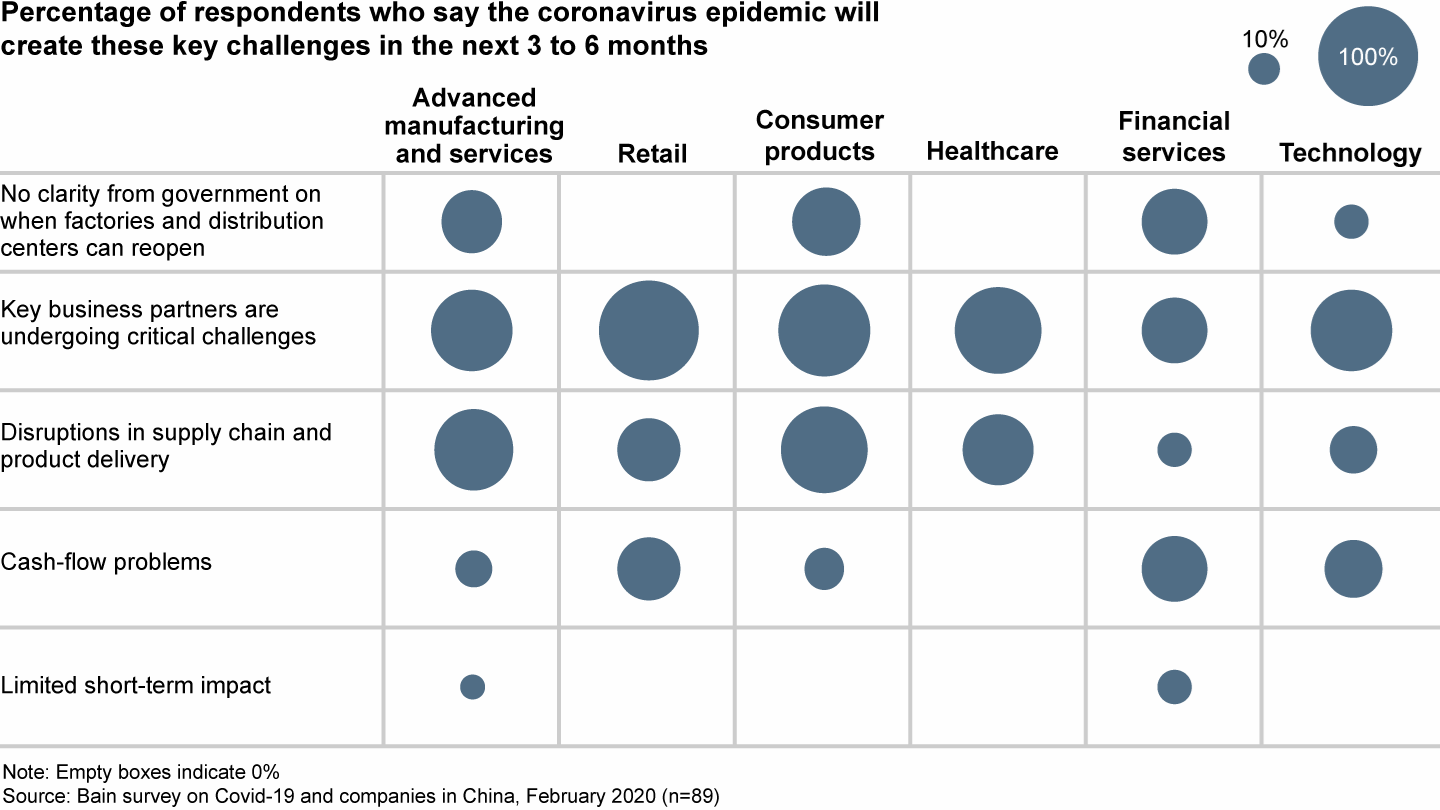
Over the next 6 to 18 months, fallout from the epidemic will include mounting operating costs (labor and raw materials, for example), supply chain disruptions, and possible deterioration in market demand. The challenges will differ from industry to industry. Retail, advanced manufacturing and financial services, for example, are tied more closely to the macroeconomic cycle and as a result, are more vulnerable to a downturn in demand (see Figure 2).
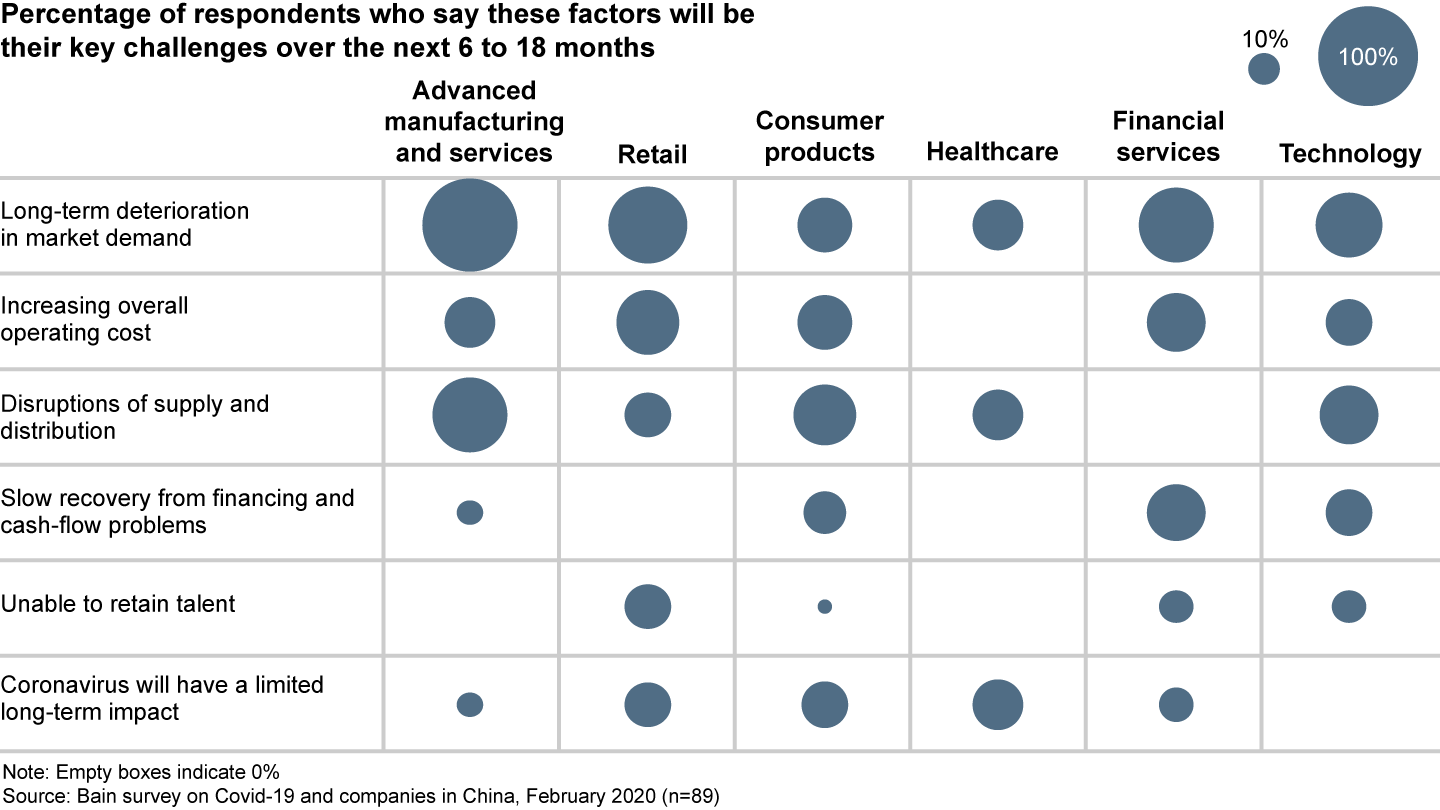
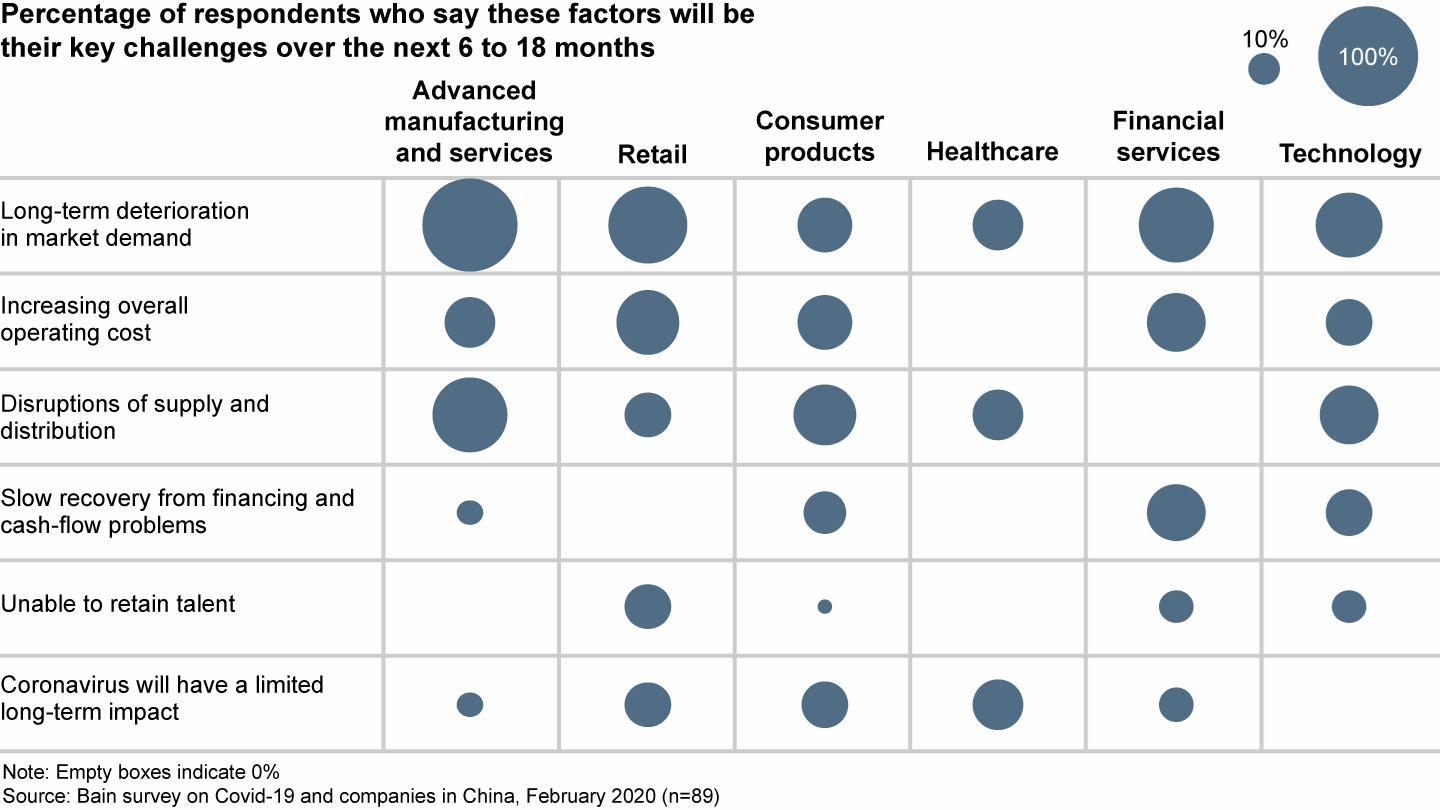
The most effective medium- to long-term responses to Covid-19 also vary from industry to industry. Advanced manufacturing, retail, financial services and technology, media and telecom typically put more emphasis on cost reduction and operational efficiency to bolster performance. Retailers, with their extensive supplier networks, tend to focus on optimizing their long-term supply chains, vendor management and inventory (see Figure 3).
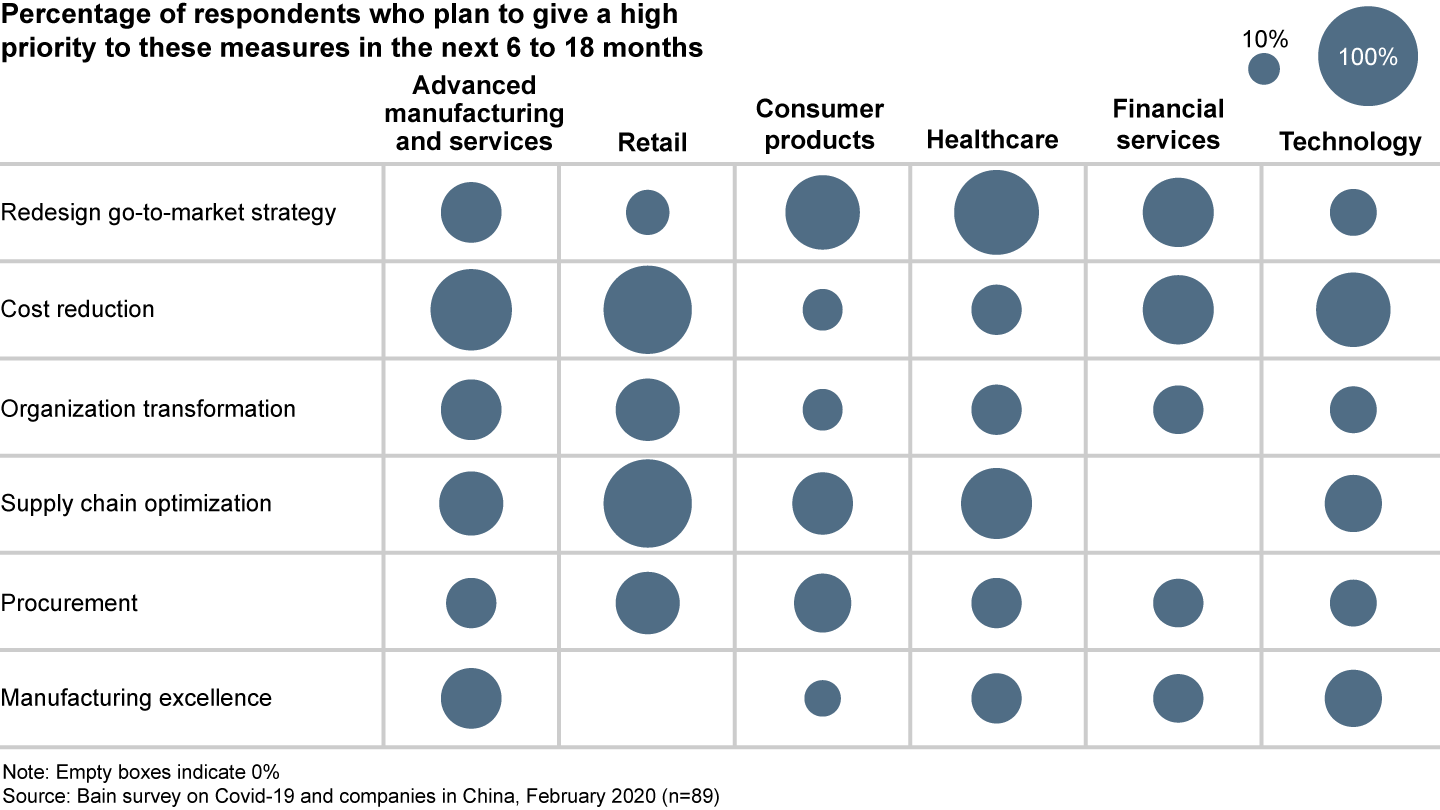
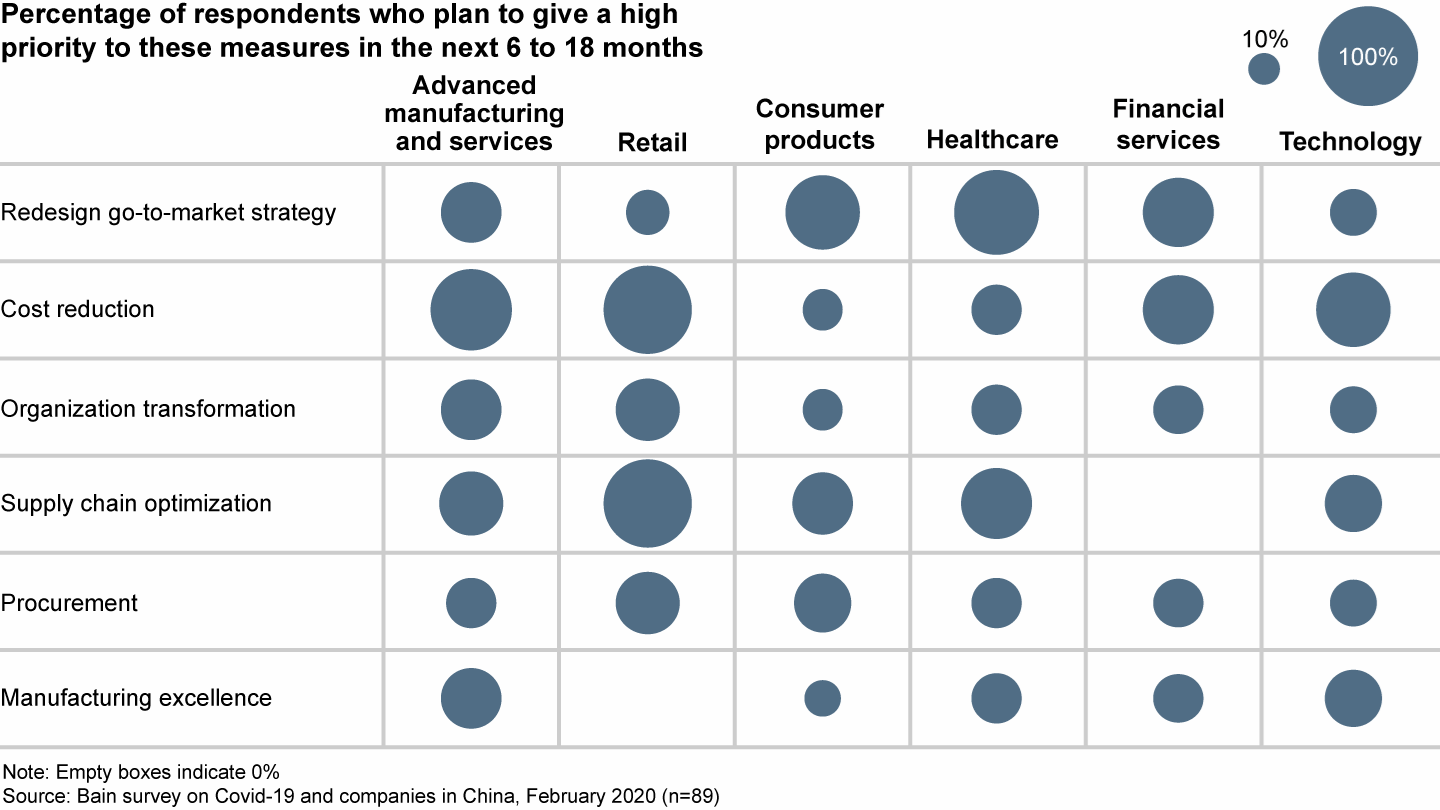
To minimize the impact of the coronavirus in the medium to long term, leading companies are starting to reduce costs and optimize their supply chains. More than 60% of the executives we interviewed pointed to labor and nonlabor costs as a top priority. Companies that focused on supply chains said sales and operations and production planning, inventory management and digitalization are critical. Leaders will also diversify their supply chains to avoid excessive reliance on a single supplier or single region
Two priorities to grow out of the crisis
The coronavirus epidemic has accelerated the pace of structural change and innovation. Leaders are taking two important steps to kick-start sustainable growth: cost reduction and supply chain optimization.
Cost reduction
For many companies, cost-cutting is a one-time reset that delivers short-term results at the expense of employees and customer experience. Our experience shows that costs eliminated by radical cuts often creep back over time. Cost productivity leaders take a more programmatic approach, following five key principles:
Define clear targets using a today-forward, future-back perspective. Cost-reduction plans with clear targets and specific measures are more likely to deliver the expected results. Leaders formulate a plan to improve current operations while developing future productivity targets and long-term strategy.
Focus on best in class vs. best in cost. Instead of cutting costs indiscriminately, successful companies adapt the cuts to their strategy. They invest in low-cost capabilities, but also build a competitive advantage to fuel sustainable growth.
Adopt a zero-based budget approach. Applying cost-reduction tools to an existing business model is likely to produce disappointing results. Leaders start from scratch to rethink processes and unearth new efficiencies. They use zero-based redesign and zero-based budgeting to align spending and investment with the firm’s stage of development.
Improve organizational capabilities. Top-down cost-reduction plans typically are difficult to implement, lack frontline commitment and produce less satisfactory results. Effective leaders give the front line a sense of ownership in change programs. They cultivate an open culture focused on productivity, streamline decision making and offer incentives that sustain results.
Harness digital solutions. Digital tools can significantly improve operations efficiency and strengthen supplier and inventory management. Leading companies deploy digital technologies to create outstanding cost and operating models.
Companies that follow these principles are likely to recover faster and emerge from the crisis stronger. One international fast-food chain in Greater China embarked on a series of cost-reduction efforts, including zero-based redesign and zero-based budgeting. The leadership team built a transparent cost baseline to reevalute its savings priorities. Using digital tools, it generated a more accurate sales forecast. That, in turn, helped optimize the costs of labor, packaging and raw material, and supported vendor evaluations and negotiations. The company met its profit goal, cut baseline costs 5% to 25%, and invested the savings in projects tied to future priorities.
Supply chain optimization
The coronavirus epidemic has dramatically changed companies’ external environment, upending the competitive landscape and collaboration along the value chain. Leading companies now are reconfiguring their supply chains for the future by focusing on three vital steps.
Align supply chain objectives with business strategy. Supply chain managers typically balance three competing priorities: improving efficiency (cost, lead time and inventory turnover, for example); reducing supply risk; and enhancing customer satisfaction. To make the right trade-offs, leaders review their medium- to long-term business strategies and focus on the factors that sharpen their competitive edge, such as speed to market, supply security, pricing or innovation. Setting strategic priorities guides future supply chain objectives and the overall supply network’s design, as well as daily supply chain operations.
Adopt a global perspective. A global supply network—including suppliers, manufacturing sites, logistics and warehousing—helps lower costs and spread risks across regions. Companies can reconfigure their manufacturing footprint by moving production to lower-cost regions such as inland China or parts of Southeast Asia. To improve supply security for core components, leaders are developing alternative suppliers and sites in other countries. They also are cultivating strategic suppliers for key technologies to avoid potential disruption from international trade disputes.
Embrace digitalization. Digital tools give managers a comprehensive view of their internal and external supply chain and provide real-time performance feedback. In addition, leaders make sure the digital platform is linked to the operating model and includes a mechanism that can rapidly engage senior executives for decisions on critical issues at the right moment.
The coronavirus outbreak has provoked unprecedented economic disruption around the world. As leadership teams in China emerge from the most acute phase of the crisis and restart operations, they are rightly focused on the long-term health of their businesses, employees and customers. Those that optimize their costs and supply chain structure will be best positioned to meet the challenges ahead and succeed in the long run.
Kelly Liu is a partner with Bain & Company and leads the firm’s Performance Improvement practice in Greater China. She is based in Bain’s Beijing office. Kevin Ye is an expert principal in Bain’s Performance Improvement practice and is based in the firm’s Shanghai office.
The authors would like to give special thanks to Peter Guarraia, the leader of Bain’s Global Supply Chain and Cost Management practices; and Raymond Tsang and Vinit Bhatia, the coleaders of Bain’s Asia-Pacific Performance Improvement practice, for their guidance. The authors also thank case team leader Zoe Cai and associate consultant Joyce Li for their contributions.

Coronavirus
The global Covid-19 pandemic has extracted a terrible human toll and spurred sweeping changes in the world economy. Across industries, executives have begun reassessing their strategies and repositioning their companies to thrive now and in the world beyond coronavirus.